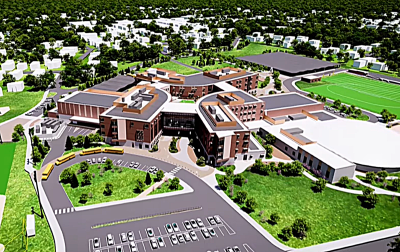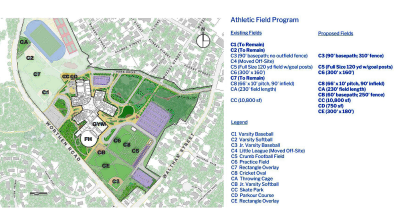Lexington High School Building for Now and Into the Future


School Building Committee Chair Kathleen Lenihan says, in the past when you entered a classroom with desks in rows, “all eyes were on the teacher,” and that now, people look at the students engaging in “active learning.”
21ST CENTURY LEARNERS NEED 21ST CENTURY CLASSROOMS

Classrooms are getting larger. The state of Massachusetts now recommends that classrooms are 825 square feet, and Lexington High Schools’ currently average 700 square feet. Larger classrooms also support the way that education is being delivered to different populations of students. Lenihan notes that in the past, there were populations of students that weren’t included in a traditional classroom. Inclusive classroom settings include mainstreaming environments where special needs students (with an Individualized Education Plan or IEP) and their in-class resource teacher attend classes alongside their general education classmates for the full day. This requires larger and more flexible classrooms. Also, the tremendous increase in technology within the classrooms creates challenges in classroom design, from digital connectivity to physical space and furniture requirements. The 21st Century learning environment is a far cry from what many folks sentimentally remember. The current community of learners needs flexible and creative physical environments as much as they need current texts and up-to-date technology. To meet increasing academic demands, Lexington must expect—and plan— for change. Nothing is certain in this era of ever-accelerating change.
These are some of the questions voters will have when they go to the polls on December 8, 2025, for this Debt Exclusion vote to vote for this major capital project.
After more than three years, the Town is heading down the home stretch of the decision to build a new high school. The debt exclusion vote comes after two Special Town Meetings on November 3 and 4th to decide whether BLOOM will proceed.
Some new cost estimates are adding to that decision. The price tag for the Town’s contribution has been $543.1 million out of a total project cost of $659.7 million. There is also $31.1 million in contingencies, in anticipation of costs such as steel tariffs and other soft costs that are not necessarily construction-related and are hard to project in this era of uncertainty.
GOOD NEWS
Some good news was shared earlier this month: The state will likely reimburse at a higher amount than previously expected.
MSBA (Massachusetts School Building Authority) is expected to now reimburse $121.3 million, up $11 million over previous estimates, according to Mike Burton, of Dore + Whittier, the Owner’s Project Manager (OPM) for Lexington.

An additional 11,000 square feet of the project is now “deemed eligible” for the grant. Burton says, “The MSBA determined that the education program supported the need for it, and we gained an additional 11,443 square footage of reimbursable space. This includes 1090 net square feet for Core Academics, 6475 NSF (Net Square Feet) for Art and Music, and 3878 NSF for Health and Physical Education. This accounts for the additional money in the MSBA grant now shown.” This is excellent news.
This would significantly reduce the contribution from the Town. See presentation slide from the October 6, 2025 meeting of the School Building Committee.
Burton characterized the larger reimbursement as “likely,” and when asked by SBC community representative Hsing Min Sha, “How likely is likely?” Burton said, “I’ve never seen it change after final scope and budget.” He said this number would be “official,” after the October 29, 2025 meeting with the MSBA. (Source: SBC meeting 10/6/25)
THE SCOPE
Chosen design BLOOM represents a newly constructed 510,000 gross square foot (GSF) high school, with a renovated field house that will include additional space to accommodate more programming. Central Administration offices are now being housed at the old Harrington School on Maple Street.
The budget includes construction costs and soft costs* as well as contingency costs for both categories. (*See slide above from October 6, 2025 SBC meeting: “Soft costs include Designer and OPM Fees, Furniture, Fixtures, Equipment, Technology, utility back charges, construction testing firms, and other project costs that the town will incur.”)
Offsetting the costs are the MSBA grant monies. Lexington became eligible for MSBA funds in 2022. Kathleen Lenihan, Chair of the SBC (School Building Committee) and member of the School Committee says Lexington had applied in the past to the MSBA but hadn’t been invited into the process. This time, Lexington was successful due in part to the overcrowding issues at the high school.
One counterargument led by community members is that BLOOM, designed for 2,395 students, will be too small the day it opens, especially due to the MBTA Communities Act, which requires Lexington to build higher-density housing near public transportation. Lexington has approved several projects that are underway, and several are in the pipeline.
Lenihan also says the Town learned a lot about forecasting enrollment from other multi-family projects 20 years ago.
The Educational Plan, completed after the MSBA invited Lexington into the grant application process, shows the population growing, “slowly” up to 100 students, while elementary school enrollment peaked in 2017-18. With the new housing law in effect starting in 2023, these forecasts will inevitably change. But by how much?
To better understand increases in enrollments resulting from the new housing, Lexington commissioned the Fougere Report, published April 2, 2025. This report was based on the previous 250 acres Lexington had initially zoned for additional housing (which was scaled back in Article 2 at a special Town Meeting in March 2025).
The report used data from existing homes, both single-family and multifamily, to “evaluate impacts on Lexington Public Schools” as well as other town departments. The main message from that report was that enrollment at Lexington High School had been falling after peaking in 2019, and enrollment increases predicted were actually smaller, and will be hard to predict as new housing comes online. As a result, enrollment changes may be a more gradual process.
VOICES AGAINST BLOOM
“Palace in the Park” is how Peter CJ Kelley, a former Select Board member, describes the BLOOM design. “I grew up in Lexington…my family has been here for over 100 years,” says Kelley. He says, “My passion has been the land, and that the land, especially the recreation fields, should not be built on.” One reason he cites is that the recreational land was gifted to the Town of Lexington in 1915 by resident Augustus Scott, who valued open green space in Lexington.
 This might have been a legal sticking point since BLOOM is proposed to be built on the football field, the Little League Field and the practice field along Worthen Road, with the football and other fields (though not all) moving to the Waltham Street side. The Little League field will be relocated off-site.
This might have been a legal sticking point since BLOOM is proposed to be built on the football field, the Little League Field and the practice field along Worthen Road, with the football and other fields (though not all) moving to the Waltham Street side. The Little League field will be relocated off-site.
However, the Town’s legal counsel unearthed a 1961 set of documents that the Town had asked the Trustees of Tufts college, who oversaw Scott’s land use, if an addition to the high school could be applied to the parameters of the instructions, and the Trustees said ‘yes’ to that question.
Kelley emphasizes that the changes proposed in 1961 didn’t affect the “functions of the land” the way BLOOM does. He says these fields afford “connectivity” that should be preserved—the “sight lines” where parents could see almost everything. He says that the “legal part is almost irrelevant,” but he’s advocating for the “value of the land” to the “citizenry of the land.”
He cites Article 97, a 1972 state Constitutional amendment that ensures protection for open land as superseding the 1961 allowance for the high school to use its current location. Currently, the Town is applying for a 1:1 swap of 8 acres of land to be built on in exchange for land to be used for fields. This has to be approved by both Town Meeting members and both houses of the state legislature.
The placement of BLOOM has not been a simple proposition. To maximize the preservation of open space, Select Board Member Joe Pato suggested rotating the BLOOM design to limit athletic field displacement. (See slide with field listings).
Kelley, who went to Lexington High School in the 1960s, says there’s a lot to like about the current open campus and though he agrees with the idea of expansion, he does not favor BLOOM but rather says, “give me a four-story building” with “no fancy” classrooms, in place of the World Languages building, and add buildings as needed. His and others’ ideas are represented in a “Staged Plan to Renew Lexington High School” on the LHS4All.com website. He would like to see the 1950s part of the building preserved, disagreeing that it’s “too small,” and if enrollment swells in certain years, 6th graders could stay at elementary schools and 9th graders at middle schools, as he’s seen done in the past.
Kelley says the current open campus prepares students for college and civic life in general. “Lexington has always made educating its young people a high priority. This can be witnessed in how the original High School was laid out. The front entry’s columns were aligned with those on the Depot in a straight line up Muzzey Street. This served as a connection for children becoming adults and a part of their community.”
VOICES FOR BLOOM
There are citizen voices in support of BLOOM including Taylor Carroll Singh, who chairs Yes4Lex.org. She says if there’s one message she’d like to get out before the debt exclusion vote in December is “voting no on December 8 does not mean no tax impact.” As it exists, the high school needs upgrades, and she cites the Town’s number of $300 million in HVAC (heat, ventilation and air conditioning).
If the debt exclusion vote doesn’t pass, Singh says it means “forfeiture of state dollars,” and future plans for renovating or rebuilding the high school will only cost more. Her group regards the property tax increases predicted in the Tax Calculator the Town has on the LHS project website as a “conservative estimate,” and indeed the Project Finances portion of the website lists the Town as using $7 million annually from the existing tax levy as well as a Capital Stabilization Fund (CSF) which is forecast to peak at $58 million, to ease the costs on residents. The CSF began in 2013 and the Town sets aside revenue for capital projects like this proposed one for the high school. This will keep property taxes down for the first few years of this proposed project.
To address cost for individuals, SBC Chair Kathleen Lenihan says, “There’s no question this is a significant amount” and “that can be challenging for residents in Town.” She says people who are “eligible and qualified” can participate in a “mitigation plan” that exists for seniors. These programs include:
Property Tax Deferral Program (Clause 41A): Seniors who meet age, residency, and income requirements can defer property tax payments until the home is sold. The deferral acts like a loan with interest, which is capped at 8% by law.
Senior Circuit Breaker Tax Credit: A state program that offers a refundable tax credit for seniors (65 or older) whose property taxes or rent exceed 10% of their total income.
- Community Preservation Act Surcharge Exemption
- Property Tax Exemptions for Disabled Vets, spouses of police and firefighters
- Property Tax Work-Off Program administered through the Council on Aging
- (SOURCE: FY2026 Property Tax Relief Brochure_202507281356124175.pdf on the town website.)
CONSTRUCTION DISRUPTIONS A CONCERN FOR PARENTS
Will construction of BLOOM be disruptive and is it enough to say, not worth it?
Often, residents have expressed concerns about how disruptive construction would be if BLOOM is built since sections of the building are very close to the existing school.
At the community meeting on September 18 ,2025, Jamie Meiser of Turner Construction said, “I build a lot of schools and generally we build it directly next to the existing school and then we demo. So, Wellesley High School was 17 feet away, Concord was 30 feet away and Josiah Quincy (in Boston) was 18 feet away. So we are skilled in doing this. We understand the concerns of the school and the community and we tend to sequence our work and such that we have the minimal impact as we can.” He adds that a temporary heat pump or “some sort of HVAC” system can be installed so students don’t have to open the windows but can have air conditioning while construction occurs nearby. Loading docs for trucks can be placed on the opposite end of the construction site away from the existing school and film can be placed on windows to eliminate the visual distraction.
Regarding ongoing comparisons to other high schools, Lenihan says that cost is due to “number of students and date on the calendar,” and that both Lexington’s existing high number of students and the construction costs that have grown significantly since COVID, are reflected in the price tag. There are other unknowns, such as tariffs for steel, that are in the contingency cost column. Other communities that do not have as many resources as Lexington, and receive higher reimbursement rates from the MSBA.
WHEN WILL LEXINGTON GET THE FINAL COST?
October 29, 2025 is a key meeting with MSBA. The Design Team (architectural firm SMMA, Turner Construction and Owner Project Manager Dore + Whittier) are at the stage of Value Engineering, or looking at where to get the most value at the lowest cost. SBC Chair Kathleen Lenihan and OPM Mike Burton both used the word “iterative” at the October 6, 2025 SBC meeting, but that evolving numbers around cost will be closest to accurate and final as design ends and building begins.
Should residents be concerned that if BLOOM goes forward, other capital projects will not be funded? At the September 18, 2025, Community Meeting, Carolyn Kosnoff, Assistant Town Manager of Finance said the answer is ‘no.’ She said, “The town does maintain a public five-year capital plan. So the majority of the projects over the next five years are things that we would handle within the tax levy. They would be part of regular expected tax increases.” There are a handful of other large projects that are anticipated at some point after the high school construction. One is the East Lexington Fire Station. She also said that there is significant HVAC replacement to be done at Clarke Middle School, and upgrades needed at the Town office building. Kosnoff also noted that the second floor of Cary Memorial Library is on the list.
Now that the basic design has been submitted to the MSBA, Brian Black, architect at SMMA, said at the October 6, 2025, SBC meeting that discussions with departments at the high school are ongoing to examine the cost of the interior in terms of technology, equipment, and furniture. This is part of the Value Engineering stage, where costs will need to be scaled to the budget.
FIELDHOUSE: ADD/RENO ADVANCES
The fieldhouse is not eligible for MSBA reimbursement, but the favored design has renovated the existing building and includes space for additional programming. The cost is $33.6 million, according to Mike Burton, OPM Dore +Whittier. There has been discussion in the SBC about whether it was better to wait to completely rebuild the fieldhouse at a later date, but the consensus as of the October 6, 2025, SBC meeting was that even a new field house wouldn’t have everything every potential stakeholder would want, so moving forward with the renovation is preferred. Who are the ‘stakeholders’? Lexington High School uses the field house for Physical Education classes and after school sports. Many students from Lexington elementary schools in addition to community members also use the high school facilities.
This current design will add 14,000 square feet to the field house. This will make space for wrestling teams and cheerleading practice, among other programs. This will solve some of the “meaningful deficit” of programming space, said Recreation Committee Vice Chair Claire Sheth at the October 6 School Building Committee Meeting. Among the Community Meetings the SBC has hosted, there has been discussion about whether the field house should have a 200-meter track as the team uses at facilities where they compete, such as the Reggie Lewis Center, TRACK at New Balance and at Boston University (BU) Track and Tennis. Lexington has a 146-meter track now and in the planned renovation. There are no public high schools that offer a 200-meter track; and only one area private school that does.
CENTRAL ADMINISTRATION: WHY AT THE HIGH SCHOOL?
As previously noted, the old Harrington Elementary School on Maple Street, where Central Administration has been for years, needs immediate upgrades. The cost of renovating the old elementary school would be $20 million, according to SBC’s Lenihan, the same relative cost as adding the offices to the proposed new high school. In November 2025, Central Administration is moving to 173 Bedford Street, where the Lexington Police were housed during the construction of their new building. Ultimately, the administration offices are expected to move into the fourth floor of the BLOOM design. Central Administration cannot remain at the Bedford Street location for several reasons. SBC’s Lenihan says that the building was purchased as “swing space” for multiple Town departments to use as needed, and it’s not a Lexington Public Schools building.
Placing Central Administration in the new high school building is also a way to prepare for enrollment increases. If additional classes are needed, Lenihan says it would be “easier to convert” the offices to classrooms rather than “getting bulldozers and build a new addition.”
SBC Chair Kathleen Lenihan thinks that this school building will last 75 years and says she “completely understands” the point of view that $659 million is a tremendous amount of money. “But it is the biggest capital project in Lexington history, and if anything deserves that kind of investment, it’s a modern high school designed to educate the children of Lexington into the 22nd century.”
The last Community Meeting was October 14, 2025. For more information on the project as a whole, visit the LHS Building Project website.
FOR MORE INFORMATION:
LHS4All.com

yes4lex.org

